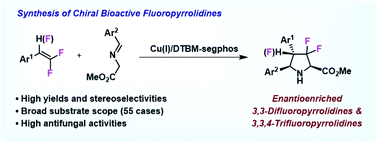Synthesis of bioactive fluoropyrrolidines via copper(i)-catalysed asymmetric 1,3-dipolar cycloaddition of azomethine ylides†
Abstract
Chiral pyrrolidinyl units are important building blocks in biologically active natural products and drugs, and the development of efficient methods for the synthesis of diverse structured pyrrolidine derivatives is of great importance. Meanwhile, incorporating fluorine containing groups into small molecules often changes their activities to a great extent due to the special physicochemical properties of fluorine atoms. Herein, we report an efficient route to obtain enantioenriched 3,3-difluoro- and 3,3,4-trifluoropyrrolidinyl derivatives by Cu(I)-catalysed enantioselective 1,3-dipolar cycloaddition of azomethine ylides with less active 1,1-difluoro- and 1,1,2-trifluorostyrenes. A series of new fluorinated pyrrolidines have been prepared in high yields (up to 96%) and with excellent stereoselectivities (up to >20 : 1 dr and 97% ee), and these unique structural blocks could be readily introduced into some natural compounds and pharmaceuticals. Additionally, antifungal activity investigation against four common plant fungi showed that some products possess general and high biological activities; comparison with the low antifungal activities of corresponding nonfluorinated compounds revealed that the fluorine atoms at the pyrrolidinyl rings play a crucial role in the antifungal activity.



 Please wait while we load your content...
Please wait while we load your content...